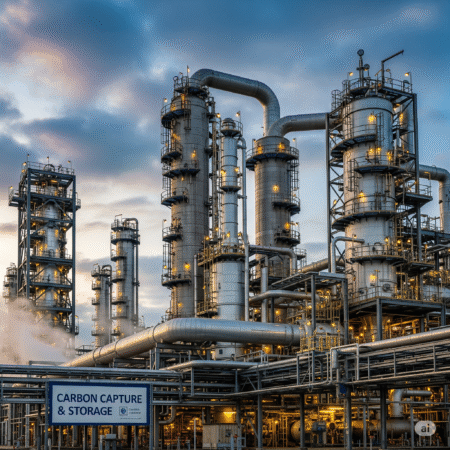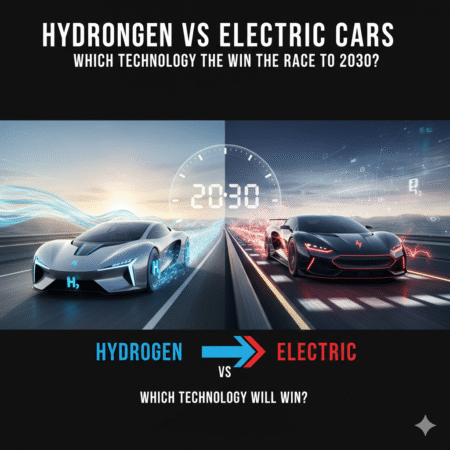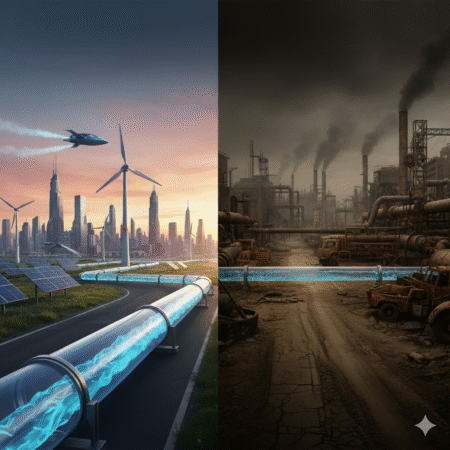
- Why Carbon Capture Is the Oil & Gas Conversation in 2025
- Carbon Capture 101 for Oil & Gas: What It Really Means
- Cost Breakdown – How Much Carbon Capture Really Costs in Oil & Gas Facilities
- Tax Credits & Incentives – US 45Q vs. EU ETS vs. UK Support
- Carbon Capture Technologies That Fit Oil & Gas
- Cluster & Hubs – How Oil & Gas Companies Plug into Shared Infrastructure
- Compliance & MRV – What Regulators Expect in 2025
- Transport & Storage – Pipeline vs. Shipping for Oil & Gas CO₂
- Case Studies 2025 – Oil & Gas Carbon Capture in Action
- De-risking Your Project – From Pilot to FID
- The Business Case – ROI, Payback, and Strategic Value
- Key Takeaways & Action Plan for Oil & Gas Leaders
Why Carbon Capture Is the Oil & Gas Conversation in 2025
Let’s be real: oil & gas isn’t going away tomorrow. Demand for energy is still rising, and countries like the US, UK, and those in the EU can’t simply switch off fossil fuels overnight. But here’s the catch-governments, investors, and even customers are demanding lower emissions today. That’s where carbon capture, utilization, and storage (CCUS) has shifted from “nice to have” to the core conversation in oil & gas boardrooms in 2025.
Why? Because three unstoppable forces are colliding right now:
- Regulatory pressure is tightening. The US has 45Q tax credits; the EU is rolling out stricter carbon pricing under ETS; and the UK is funding CCUS clusters. If oil & gas companies don’t act, they’ll pay higher penalties and lose permits.
- Investor scrutiny is sharper than ever. ESG funds, banks, and even insurance providers now look at CCUS adoption before committing capital. No CCUS, no money.
- Projects are finally real, not just PowerPoint slides. From Norcem Brevik cement in Norway shipping CO₂ to Northern Lights, to HyNet in the UK, industrial-scale CCUS projects are operating or under construction. That means oil & gas facilities can no longer say “it’s unproven.”
The Big Picture in Numbers
Here’s what the landscape looks like in 2025:
| Region | What’s Driving Carbon Capture? | Why Oil & Gas Can’t Ignore It |
|---|---|---|
| US | 45Q tax credits up to $85/ton, DOE funding | Massive savings if you qualify-cheaper than paying penalties |
| EU | ETS carbon price hovering €80–€100/ton | Refiners & LNG plants hit hardest-compliance costs skyrocket |
| UK | CCUS cluster model (HyNet, East Coast) | Shared infrastructure = lower entry cost for oil & gas emitters |
Why This Matters to Oil & Gas Executives
- Survival, not PR. Carbon capture is the difference between staying in business or being shut out of markets.
- Competitive advantage. Early adopters lock in incentives, storage slots, and investor goodwill.
- Future-proofing assets. Capturing CO₂ at refineries and gas plants extends asset life in a decarbonizing world.
Bottom line: 2025 is the tipping point. Oil & gas companies that move now on carbon capture can secure incentives, reduce exposure to carbon pricing, and keep investors onside. Those that delay? They’ll be paying higher penalties, facing stranded assets, and losing their license to operate.
Carbon Capture 101 for Oil & Gas: What It Really Means
When people hear “carbon capture,” a lot of them imagine some futuristic machine sucking CO₂ straight out of the sky. That’s direct air capture (DAC)-cool tech, but not what most oil & gas facilities are actually doing in 2025.
For oil & gas, carbon capture is about tackling concentrated CO₂ streams right at the source: refineries, LNG terminals, petrochemical plants, and natural gas processing units. Why? Because these facilities already have high CO₂ concentrations in their exhaust or process streams, making capture way more cost-effective than chasing dilute CO₂ in the open air.
So, what does carbon capture really mean for oil & gas players today? Let’s break it down.
The Three Core Steps of Carbon Capture
- Capture at Source
- Using technologies like amine absorption, membranes, or cryogenic separation.
- Focused on flue gas or process CO₂ streams.
- Compression & Transport
- Once captured, CO₂ is compressed into a dense phase.
- Shipped via pipeline or vessel to storage hubs (e.g., Northern Lights, HyNet).
- Utilization or Storage (U or S in CCUS)
- Storage: Injected into deep saline formations or depleted oil & gas reservoirs.
- Utilization: In some cases, used for enhanced oil recovery (EOR) or feedstock for chemicals/fuels.
Quick Comparison: Point Source vs. Direct Air Capture (DAC)
| Capture Method | Where It Works | Relevance for Oil & Gas |
|---|---|---|
| Point Source Capture | Refineries, LNG, petrochem plants | High – cheaper, CO₂ concentration already high |
| Direct Air Capture (DAC) | Open air, ambient CO₂ | Low – costly, not main route for O&G facilities in 2025 |
Why Oil & Gas Should Care
- Biggest emitters = biggest opportunities. Refineries and LNG plants are among the top stationary CO₂ sources.
- Regulators are targeting these facilities first. ETS and 45Q frameworks prioritize industrial point-sources.
- Fast wins. Capturing CO₂ at these concentrated sources can deliver quicker tons-captured per dollar compared to DAC.
In short: carbon capture in oil & gas isn’t sci-fi-it’s process engineering. It’s about bolting proven capture systems onto existing plants, then plugging into transport and storage hubs. And in 2025, the infrastructure finally exists to make this practical.
Cost Breakdown – How Much Carbon Capture Really Costs in Oil & Gas Facilities
Let’s talk about the elephant in the room: carbon capture is not cheap.
That’s why every CFO in oil & gas asks the same question: “How much is this really going to cost us?”
The truth? It depends. Costs vary by technology, plant type, CO₂ concentration, energy prices, and even the distance to a storage hub. But by 2025, we finally have enough real projects to give you ballpark figures you can actually use.
The Two Big Buckets of Cost
- CAPEX (Capital Expenditure)
- Equipment purchase (capture unit, compressors, pipelines).
- Engineering, procurement, construction (EPC).
- Integration with existing plant utilities.
- OPEX (Operating Expenditure)
- Energy penalty (steam/electricity for capture + compression).
- Solvent/membrane replacement and maintenance.
- Monitoring, verification, and reporting (MRV).
Typical Cost Ranges in Oil & Gas (2025 Estimates)
| Category | Range (per ton CO₂ captured) | Key Driver |
|---|---|---|
| Capture | $40 – $70 | Higher if CO₂ stream is dilute (e.g., refinery flue gas); lower if concentrated (gas processing) |
| Compression & Transport | $10 – $20 | Distance to hub; pipeline vs. ship |
| Storage | $10 – $15 | Depends on geology & hub fees |
| Total | $60 – $105 | Full chain CCS (Capture + Transport + Storage) |
What Moves the Needle on Costs
- CO₂ concentration. Natural gas processing plants often have higher CO₂ content → cheaper to capture.
- Scale. Larger facilities can spread fixed costs across more tons.
- Proximity to hubs. Being near HyNet (UK) or Northern Lights (EU) can cut transport/storage fees drastically.
- Policy incentives. In the US, 45Q can offset up to $85/ton captured and stored. That can make CCUS not just affordable, but profitable.
Why Costs Aren’t the Whole Story
Here’s the kicker: while $60–$100 per ton may sound high, compare it to EU ETS carbon prices of €80–€100/ton or potential penalties for non-compliance. Suddenly, capture looks cheaper than doing nothing.
Bottom line: In oil & gas, the cost of carbon capture isn’t pocket change-but with 45Q credits in the US and cluster access in the UK/EU, it’s rapidly shifting from a compliance cost to a competitive advantage.
Tax Credits & Incentives – US 45Q vs. EU ETS vs. UK Support
Let’s be real: carbon capture in oil & gas only scales if the money works. And in 2025, the biggest driver of CCUS adoption isn’t just technology-it’s tax credits and carbon pricing systems.
Governments in the US, EU, and UK are rolling out some of the strongest incentive schemes we’ve ever seen. If you’re an oil & gas player, knowing which levers to pull can mean the difference between a stranded project and one that actually delivers ROI.
United States: 45Q Tax Credits
- What it is: A federal tax credit that pays per ton of CO₂ captured and stored.
- How much:
- $85/ton for CO₂ permanently stored in geological formations.
- $60/ton for CO₂ used in enhanced oil recovery (EOR).
- Who qualifies: Power plants, refineries, LNG terminals, natural gas processing, petrochem plants.
- Why it matters: For many projects, 45Q covers a huge chunk of OPEX, making capture competitive with just paying carbon penalties.
European Union: EU ETS (Emissions Trading System)
- What it is: A cap-and-trade carbon pricing system. Companies must surrender allowances (EUAs) for every ton of CO₂ emitted.
- Carbon price in 2025: Hovering €80–€100/ton.
- Who qualifies: Large emitters in oil refining, petrochemicals, power generation, and heavy industry.
- Why it matters: If you capture and store CO₂, you don’t need to buy allowances—so the “savings” equal avoided EUA costs.
United Kingdom: CCUS Cluster Model
- What it is: Government-backed CCUS industrial clusters (HyNet, East Coast, Acorn). Companies can plug into shared transport and storage infrastructure.
- Support mechanisms:
- Contracts for Difference (CfDs) to stabilize revenue.
- Grants and co-investment to lower CAPEX.
- Why it matters: Lowers barriers for mid-sized oil & gas emitters who can’t afford full CCS value chain alone.
Quick Comparison Table
| Region | Incentive Mechanism | Value per Ton (2025) | Best Fit for Oil & Gas |
|---|---|---|---|
| US | 45Q tax credit | $60–$85/ton | Refinery, LNG, gas processing |
| EU | ETS carbon pricing | €80–€100/ton avoided | Refineries, petrochem, LNG |
| UK | CCUS cluster support + CfDs | Varies, CAPEX grants + stable price | Mid-sized emitters near clusters |
Key Insight for Oil & Gas Leaders
- In the US, carbon capture can literally turn into a profit center if you optimize around 45Q.
- In the EU, it’s less about “extra revenue” and more about avoiding massive costs from EUA purchases.
- In the UK, shared infrastructure removes the “too expensive” excuse-making it easier for smaller oil & gas players to join the CCUS ecosystem.
Bottom line: Whether it’s credits, avoided costs, or shared hubs, the financial case for carbon capture in 2025 has never been stronger. The smartest oil & gas companies are the ones that treat policy incentives as part of their core business strategy-not as an afterthought.
Carbon Capture Technologies That Fit Oil & Gas
When it comes to carbon capture, not all technologies are created equal. Oil & gas facilities-from refineries to LNG plants-produce very different streams of CO₂. Some are highly concentrated, others are dilute and mixed with impurities. That means the “right” technology isn’t about what’s hottest in the market-it’s about fit-for-purpose solutions.
Here’s a breakdown of the main options oil & gas players are betting on in 2025:
Amine-Based Solvent Systems (The Workhorse)
- How it works: CO₂ is absorbed into a liquid solvent (usually amines) and then stripped using heat.
- Best fit: Natural gas processing, refineries, LNG trains.
- Pros: Mature, reliable, proven at scale.
- Cons: High energy use (steam), solvent degradation, corrosion.
Membrane Separation (Lightweight & Modular)
- How it works: CO₂ passes selectively through polymer or ceramic membranes.
- Best fit: Smaller gas processing units, offshore platforms, modular LNG.
- Pros: Compact, no solvents, lower maintenance.
- Cons: Less efficient for dilute streams, may require hybrid with solvents.
Cryogenic Separation (Cool Tech, Literally)
- How it works: CO₂ is separated by cooling gases to very low temperatures, liquefying CO₂.
- Best fit: High-pressure CO₂ streams, LNG facilities (where cryogenic cooling already exists).
- Pros: Produces high-purity CO₂, integrates well with LNG cold energy.
- Cons: Energy intensive, expensive if applied to dilute flue gas.
Point Source Capture vs. Direct Air Capture (DAC)
- Point Source Capture: Capturing CO₂ where it’s emitted (e.g., refinery stacks, LNG plants). Most oil & gas projects focus here-it’s cheaper and more concentrated.
- Direct Air Capture (DAC): Pulls CO₂ directly from the atmosphere. Game-changer for “negative emissions,” but still very costly ($500+/ton). For oil & gas, DAC is more about future offsets than current operations.
Technology Snapshot for Oil & Gas
| Technology | Maturity (2025) | Best Use Case | Key Challenge |
|---|---|---|---|
| Amine solvents | High | Refineries, gas processing | High energy demand |
| Membranes | Medium | Offshore, modular plants | Lower efficiency |
| Cryogenic | Medium | LNG, high-pressure streams | High cost for dilute gas |
| Direct Air Capture | Early | Offsets, negative emissions | Very expensive |
Key Takeaway
Oil & gas companies don’t need to reinvent the wheel. The smartest players in 2025 are mixing proven tech (amines) with emerging options (membranes, cryogenics) to optimize cost and footprint. DAC might grab headlines, but for oil & gas operations, point source capture remains the fastest, cheapest path to compliance and ROI.
Cluster & Hubs – How Oil & Gas Companies Plug into Shared Infrastructure
Here’s the reality: building your own carbon capture, transport, and storage (CCS) chain is insanely expensive. Pipelines, offshore storage, permits-none of this comes cheap. That’s why the biggest oil & gas opportunity in 2025 isn’t going solo. It’s about plugging into CCS clusters and hubs.
These shared networks allow multiple emitters-refineries, LNG plants, chemical producers-to connect to a common CO₂ transport and storage system. Think of it as an “industrial Uber” for captured carbon: you just pay for your ride, instead of buying the whole car.
Why Clusters Matter for Oil & Gas
- Lower Costs: CAPEX is shared across industries.
- Faster Deployment: No need to design end-to-end infrastructure alone.
- Regulatory Friendly: Governments prioritize clusters in funding + permitting.
- Scalable: Easy to add new emitters once the backbone exists.
Major CCS Clusters in 2025
- HyNet (United Kingdom)
- Covers North West England & North Wales.
- Anchor industries: refineries, hydrogen production, power.
- Oil & Gas tie-in: refineries can capture flue gas and ship CO₂ to Liverpool Bay storage.
- Northern Lights (Norway)
- Flagship European CCS project, backed by Equinor, Shell, and TotalEnergies.
- CO₂ shipped from emitters across Europe to offshore storage under the North Sea.
- Oil & Gas tie-in: LNG facilities and petrochem plants in EU can export CO₂ here.
- Ravenna CCS (Italy)
- Joint project with Eni + partners.
- Uses depleted offshore gas fields as CO₂ storage.
- Oil & Gas tie-in: downstream oil refining and gas power plants in Italy.
Snapshot of CCS Hubs for Oil & Gas
| Cluster | Location | Best Fit for O&G | Key Advantage |
|---|---|---|---|
| HyNet | UK (Liverpool Bay) | Refineries, hydrogen plants | Strong UK gov’t support, CfDs |
| Northern Lights | Norway + EU import | LNG, petrochem, refineries | First mover, cross-border shipping |
| Ravenna | Italy (Adriatic) | Refining, gas-fired plants | Uses depleted gas fields, local synergy |
Key Takeaway
For oil & gas companies, clusters mean one thing: you don’t have to build everything yourself. By plugging into hubs like HyNet, Northern Lights, or Ravenna, you can slash project risk, speed up timelines, and secure government support.
The smartest oil & gas leaders in 2025 are already booking storage slots in these hubs-because once capacity fills up, latecomers could be left stranded with no place to store their CO₂.
Compliance & MRV – What Regulators Expect in 2025
Here’s the deal: capturing carbon is only half the battle. The other half is proving that you actually did it-and that the CO₂ stays underground. In 2025, regulators in the US, UK, and EU are turning up the heat on compliance and MRV (Monitoring, Reporting, Verification) for carbon capture projects in oil & gas.
Why MRV is Non-Negotiable
- Tax Credits & Incentives: Programs like US 45Q or EU ETS only pay if CO₂ is properly monitored and verified.
- Environmental Integrity: Regulators want proof that CO₂ won’t leak back into the atmosphere.
- Investor Confidence: Banks and funds demand third-party verification before financing CCS projects.
- Reputation: For oil & gas, MRV is the difference between “greenwashing” and real ESG credibility.
What Regulators Expect in 2025
- Continuous Monitoring
- Use sensors, satellite data, and subsurface modeling.
- Leak detection systems are now mandatory in US and EU clusters.
- Granular Reporting
- Not just annual numbers. Monthly or even real-time CO₂ accounting is expected.
- Regulators push for blockchain-based MRV pilots (esp. in EU).
- Independent Verification
- Third-party auditors must confirm CO₂ captured, transported, and stored.
- UK ETS requires accredited verifiers for every reporting cycle.
- Cross-Border Alignment
- If CO₂ is shipped (e.g., from Germany to Northern Lights in Norway), MRV rules from both jurisdictions must align.
Compliance Requirements Snapshot (2025)
| Region | Key Requirement | Oil & Gas Impact |
|---|---|---|
| US (45Q) | Continuous monitoring + EPA Class VI well reporting | Needed for tax credit eligibility |
| EU ETS | Third-party verification + lifecycle CO₂ tracking | Higher cost, but strong carbon price upside |
| UK ETS | Granular MRV + accredited verifier audits | Essential for participation in CCS clusters |
Key Takeaway
In 2025, MRV is no longer a box-ticking exercise-it’s the backbone of carbon capture credibility. For oil & gas companies, the winners will be those who embed MRV systems into project design from day one, not as an afterthought.
Without airtight compliance, you risk losing incentives, investor trust, and even your license to operate.
Transport & Storage – Pipeline vs. Shipping for Oil & Gas CO₂
Capturing CO₂ is useless if you can’t move it. For oil & gas players in 2025, the big decision is whether to transport captured carbon through pipelines or shipping. Both options have unique cost curves, risks, and regulatory hurdles.
Read More: AI for Renewable Energy Forecasting: Proven Techniques to Boost Solar & Wind Accuracy
Pipeline: The Traditional Workhorse
- Pros:
- Proven technology (used in US for decades in EOR).
- High throughput once built → low OPEX per ton.
- Integrated into CO₂ clusters (e.g., US Gulf Coast, UK East Coast).
- Cons:
- Huge upfront CAPEX (permitting + construction).
- Siting challenges → landowner opposition, regulatory red tape.
- Lock-in to fixed routes → less flexible if capture sites move.
Shipping: The New Flex Option
- Pros:
- Flexibility: CO₂ can be moved between countries/clusters (e.g., Northern Lights in Norway receiving EU shipments).
- Faster to deploy for pilot projects (no need for 1,000 km pipeline).
- Ideal for offshore storage hubs.
- Cons:
- Higher per-ton transport cost vs. large pipelines
- Requires liquefaction terminals + specialized CO₂ carriers.
- Emerging regulatory complexity for cross-border CO₂.
Cost & Technical Snapshot (2025)
| Factor | Pipeline | Shipping |
|---|---|---|
| CAPEX | High upfront (>$1B for 1,000 km) | Moderate (liquefaction + port infra) |
| OPEX/ton | Low (~$2–4/ton at scale) | Higher (~$8–15/ton) |
| Scalability | Best for large, steady volumes | Best for dispersed, variable volumes |
| Regulatory | Domestic approval + safety | Cross-border treaties, IMO guidelines |
| Flexibility | Fixed route | Route & hub-based flexibility |
What Oil & Gas Should Do in 2025
- Short-term projects / pilots: Shipping makes more sense → faster deployment, lower sunk cost.
- Long-term / gigaton-scale: Pipelines remain the cheapest backbone.
- Hybrid model: Many CCS clusters (UK, EU) plan to use both-pipelines feeding domestic hubs + shipping for export/import.
Key Takeaway
In carbon transport, there is no one-size-fits-all solution. Oil & gas leaders should see pipelines as the “highway” for large-scale CCS, while shipping acts as the “shuttle service” to plug smaller projects into global CO₂ hubs.
The winners will be those who design with flexibility-so captured carbon always has a reliable path to permanent storage.
Case Studies 2025 – Oil & Gas Carbon Capture in Action
Carbon capture in oil & gas is no longer theory-it’s happening today. In 2025, several high-profile projects act as proof points, showing how capture, transport, and storage can scale. These case studies provide lessons for leaders weighing their own investment.
Brevik Cement & Northern Lights (Norway)
- Sector: Cement, but integrated with oil & gas storage hubs.
- Scale: 400,000 tons CO₂/year, shipped to Northern Lights offshore storage.
- Why it matters: Shows that shipping CO₂ works. Oil & gas firms like Equinor are central to the logistics and permanent storage, proving cluster models are viable.
ExxonMobil’s Baytown CCS (US Gulf Coast)
- Sector: Refining & petrochemicals.
- Scale: Part of a proposed Houston Ship Channel hub, targeting tens of millions of tons CO₂/year by 2030.
- Why it matters: Demonstrates how oil majors are leveraging tax credits (US 45Q) to de-risk projects and anchor cluster development.
UK East Coast Cluster (Teesside & Humber)
- Sector: Power + industrial (incl. oil & gas downstream).
- Scale: 20–30 Mt CO₂/year potential storage.
- Why it matters: Integration of multiple emitters via shared pipelines into offshore saline aquifers. Oil & gas firms like BP are central to cluster operation, showing how infrastructure sharing cuts costs.
LNG Pilot Projects (Qatar & Australia)
- Sector: LNG liquefaction & processing.
- Scale: Small-scale pilots (0.5–1 Mt/year) tied to large LNG exports.
- Why it matters: Tests CO₂ capture directly from natural gas processing. Success here could unlock massive reductions in LNG’s lifecycle emissions, securing license-to-operate in Asia and Europe.
Key Lessons for Oil & Gas Leaders
- Clusters reduce risk & cost – Standalone CCS is too expensive; shared hubs make it bankable.
- Policy drives action – US 45Q, EU ETS, and UK CfDs are tipping projects from concept to FID.
- Shipping is real – Norway’s Northern Lights proves cross-border CO₂ trade is viable.
- Oil & gas incumbents are essential – Their expertise in geology, pipelines, and offshore operations gives them a structural advantage.
Takeaway
2025 case studies prove CCS is no longer “waiting for the future”-it’s underway, with oil & gas at the center. The challenge now is scaling from pilots to gigatons-and the companies that move first will define the global carbon infrastructure of the next 30 years.
De-risking Your Project – From Pilot to FID
Carbon capture projects in oil & gas rarely fail for lack of technology-they stall because of risk. From regulatory approvals to long-term offtake agreements, the road from pilot to final investment decision (FID) requires systematic de-risking. In 2025, companies pursuing CCS need to follow a structured checklist to improve bankability and accelerate time-to-market.
Step 1: Secure Permits Early
- Challenge: CCS projects cross multiple regulatory frameworks (environmental permits, CO₂ transport licenses, offshore storage approvals).
- Action: Start permitting in parallel with engineering studies. Engage regulators early to avoid bottlenecks-especially in the EU and UK where storage licenses can take 2–3 years.
Step 2: Lock in Policy & Tax Incentives
- Challenge: Revenue models for CCS depend heavily on incentives (US 45Q, UK CfD, EU ETS credits).
- Action: Build financial models around confirmed credit values. Negotiate certainty clauses with governments or partners where possible. In the US, secure eligibility confirmation from the IRS early to satisfy investors.
Step 3: Secure Offtake or Storage Agreements
- Challenge: Without clear long-term storage contracts, CCS projects remain speculative.
- Action: Sign MOUs or binding agreements with storage hubs (e.g., Northern Lights in Norway, East Coast Cluster in the UK). Where shipping is involved, align transport and storage timelines to avoid stranded assets.
Step 4: Align Financing & Risk-Sharing
- Challenge: Lenders and equity partners are wary of unproven CCS cash flows.
- Action:
- Use blended financing (government grants + private equity + corporate balance sheet).
- Share risk via joint ventures across emitters, transporters, and storage operators.
- Explore green bonds or sustainability-linked loans tied to verified CO₂ reductions.
Step 5: Build Social & ESG License
- Challenge: CCS faces skepticism (accusations of “greenwashing”) if not paired with transparency.
- Action: Communicate project benefits clearly-local jobs, reduced emissions, compliance with net-zero targets. Publish MRV (measurement, reporting, verification) frameworks early.
Practical Checklist for Oil & Gas CCS Projects
- Permitting plan aligned with regulators
- Financial model stress-tested for policy scenarios
- Signed transport & storage agreements
- Risk-sharing via JV or consortium structure
- Transparent ESG communications
Takeaway
Moving from pilot to FID in CCS is less about technology and more about risk allocation. Oil & gas companies that master permitting, incentives, offtake, and financing can move decisively, while others remain stuck in endless feasibility studies.
The Business Case – ROI, Payback, and Strategic Value
For oil & gas executives, carbon capture is not just a compliance expense-it can be a strategic lever for long-term value. The business case in 2025 rests on three dimensions: financial payback, reputational upside, and market access.
ROI & Payback Window
- CAPEX & OPEX: Typical CCS projects require $500M–$1B for large-scale capture and transport. OPEX ranges $30–$80 per ton captured depending on technology.
- Revenue Streams:
- US 45Q tax credit: up to $85/ton (storage) or $60/ton (utilization).
- EU ETS allowance: trading at €80–100/ton in 2025.
- UK CfD (Contracts for Difference): guarantees strike prices for CO₂ abatement.
- Payback Outlook:
- With strong policy support (US/EU/UK), projects can achieve 5–8 years payback.
- Without credits, projects stretch to 15+ years, making incentives the hinge factor.
Strategic ESG Value
- License to Operate: CCS helps oil & gas companies maintain social license in jurisdictions tightening emissions caps.
- ESG Ratings: Verified CO₂ reductions can boost ESG scores, improving access to sustainable capital and lowering cost of debt.
- Reputation & Partnerships: Firms visibly investing in CCS gain leverage in negotiations with governments, regulators, and industrial offtakers seeking low-carbon supply chains.
Market Access & Future-Proofing
- Hydrocarbon Exports: EU and UK buyers increasingly demand low-carbon LNG and refined products. CCS becomes a ticket to market access.
- Industrial Alliances: Oil & gas CCS infrastructure (pipelines, hubs, shipping) can evolve into shared platforms, creating new revenue models as third parties pay for access.
- Optionality: CCS positions companies to participate in emerging carbon markets (credits, removals), diversifying future revenue.
Practical Framing for Executives
- Frame CCS not as cost center, but as long-term asset with multiple revenue pathways.
- Highlight payback window in scenarios: “Best case = 6 years with 45Q + ETS; Base case = 9 years; Stress case = 14 years.”
- Link CCS investment to market differentiation in LNG, petrochemicals, and refining.
Takeaway
The economics of CCS in oil & gas are increasingly bankable-if projects are structured to capture policy incentives and market premiums. Beyond ROI, CCS buys strategic relevance, ensuring companies can sell into low-carbon markets and maintain ESG credibility.
Key Takeaways & Action Plan for Oil & Gas Leaders
Carbon capture is no longer optional for oil & gas companies in 2025-it is a strategic necessity. The economics are improving, regulatory drivers are intensifying, and access to shared infrastructure is expanding. What matters now is execution.
Key Takeaways
- Costs are real, but shrinking: CAPEX and OPEX remain high, but tax credits (US 45Q), carbon markets (EU ETS), and UK support significantly shorten payback.
- Technology is deployment-ready: Amine and membrane systems dominate near-term oil & gas applications, while cryogenic and DAC remain longer-term options.
- Infrastructure is scaling fast: From Norway’s Northern Lights to UK clusters and US Gulf Coast hubs, oil & gas players can now plug into shared transport and storage networks.
- Regulation is tightening: Compliance, MRV, and documentation requirements are no longer negotiable-they are core to project bankability.
- Strategic upside matters: CCS is not only about compliance-it protects market access, strengthens ESG ratings, and creates new commercial models.
Action Plan for Oil & Gas Executives
- Audit Your Portfolio: Identify high-emission assets (refineries, LNG, upstream) where CCS economics make sense under US/EU/UK frameworks.
- Secure Incentives Early: Engage with regulators and agencies to lock in 45Q, ETS allowances, or UK CfDs-these define payback.
- Choose the Right Model: Decide whether to build proprietary CCS assets or plug into hubs/clusters (HyNet, Ravenna, Gulf Coast).
- De-risk FID: Build partnerships with technology providers, storage operators, and offtakers to improve bankability.
- Communicate the Value: Position CCS investments not as a regulatory burden, but as a pathway to premium markets and stronger ESG ratings.
Executive CTA
The first movers in CCS will set the competitive benchmark in 2025. Oil & gas leaders should not wait for perfect clarity-the window for advantaged projects is open now. The companies that act today will secure incentives, shape infrastructure, and define the low-carbon energy landscape.





